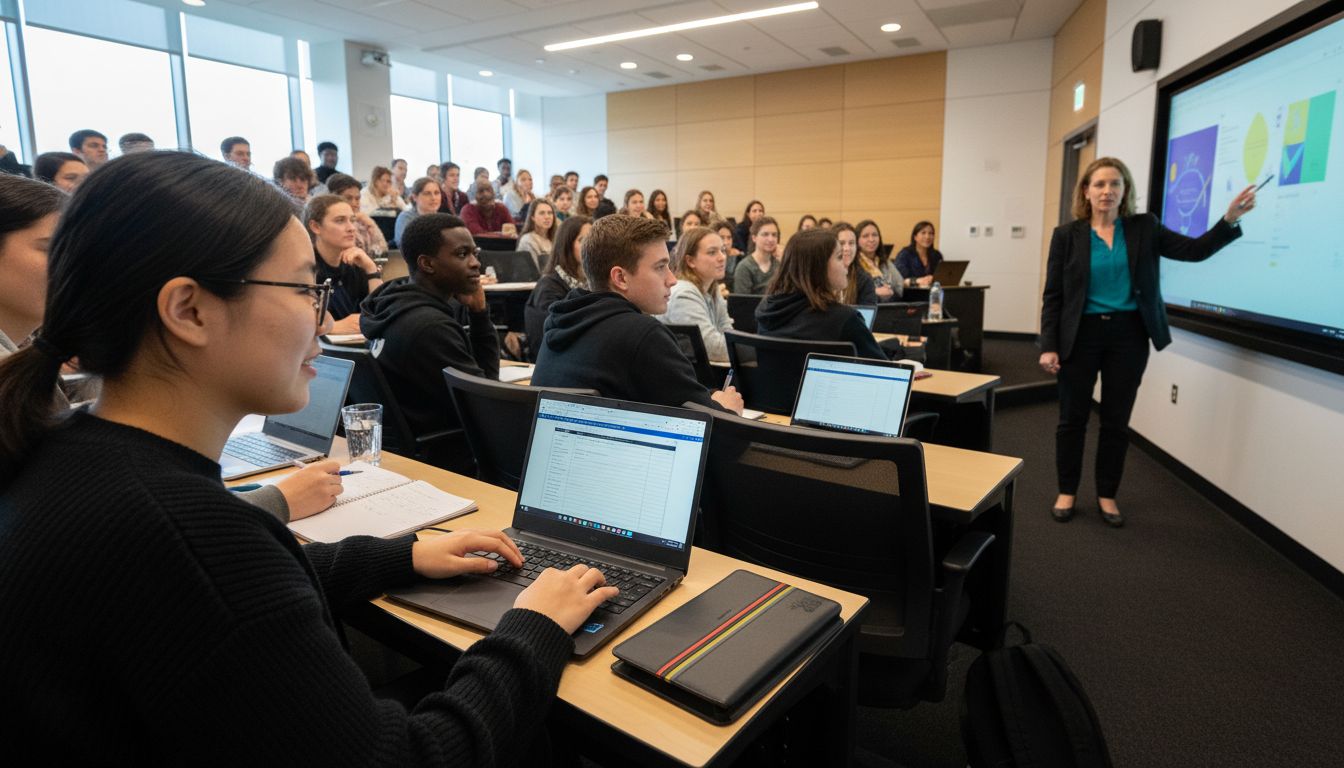Note-Taking Strategies Step by Step for Maximum Retention

Over 80 percent of american students struggle to retain important information from lectures and meetings without a solid note-taking strategy. In classrooms and boardrooms across the country, effective notes make the difference between forgotten facts and lasting knowledge. Learning how to clarify objectives, choose the best techniques, and organize your thoughts will help you turn every page of notes into a tool for real understanding and strong recall.
Table of Contents
- Step 1: Identify Your Note-Taking Objectives
- Step 2: Select The Most Effective Method
- Step 3: Organize Key Points And Insights
- Step 4: Summarize And Review Critical Information
- Step 5: Evaluate And Refine Your Notes
Quick Summary
| Key Insight | Explanation |
|---|---|
| 1. Define Your Note-Taking Objectives | Establish specific goals for your notes to enhance focus and retention. This helps prioritize important information. |
| 2. Choose an Effective Note-Taking Method | Select a note-taking method that aligns with your learning style to improve comprehension and organization. |
| 3. Organize Information Logically | Use clear headings, bullet points, and logical flow to structure notes for easier review and recall. |
| 4. Summarize and Review Regularly | Periodically summarize key information to reinforce learning and improve long-term retention of concepts. |
| 5. Evaluate and Refine Your Notes | Regularly assess the effectiveness of your notes and adjust strategies to enhance study habits and comprehension. |
Step 1: Identify Your Note-Taking Objectives
Successful note-taking starts with understanding your specific learning goals and information capture needs. According to JMU, effective note-taking begins with understanding the purpose behind your notes, which guides the selection of appropriate methods and enhances retention.
To identify your objectives, ask yourself key questions: What is the primary purpose of these notes? Are you preparing for an exam, conducting research, documenting a meeting, or trying to retain key insights from a lecture? MCPHS highlights that clarifying your note-taking objectives helps focus on key information, leading to more organized and purposeful notes. For academic settings, your objective might involve capturing main concepts, identifying critical definitions, or tracking potential exam topics. In professional contexts, your goals could include tracking action items, capturing strategic insights, or creating a reference for future decision-making.

Pro tip: Create a quick objective statement before each note-taking session. Write down 1-2 specific goals to keep yourself focused and intentional. This simple practice transforms random note-taking into a strategic learning process.
Step 2: Select the Most Effective Method
Choosing the right note-taking method is crucial for transforming information absorption into lasting knowledge. JMU emphasizes that selecting a note-taking method aligned with your learning style can significantly improve comprehension and retention.
Different methods suit different learning scenarios. According to MCPHS, employing various techniques like outlines or concept maps allows for better organization and understanding of material. Consider these popular approaches: the Cornell Method for structured lecture notes, Mind Mapping for creative and visual learners, Outline Method for linear thinkers, and Charting Method for comparing and contrasting information. Your ideal method depends on your personal learning style, the type of content, and your specific objectives. For instance, scientific lectures might benefit from structured outlining, while brainstorming sessions could thrive with mind mapping techniques.
Pro tip: Experiment with multiple note-taking methods. Do not lock yourself into one approach. Try different techniques during a single week and observe which helps you retain and understand information most effectively. Flexibility is key to finding your optimal note-taking strategy.
Step 3: Organize Key Points and Insights
Structuring your notes effectively transforms raw information into a powerful learning tool. JMU emphasizes that using clear headings and subheadings helps organize key points, making review sessions significantly more efficient.
When organizing insights, focus on creating a logical flow that makes sense to you. MCPHS recommends utilizing bullet points and numbering to aid in organizing information logically, which facilitates easier recall. Start by identifying the main concept or lecture theme, then break it down into primary subtopics. Use consistent formatting like indentation to show hierarchical relationships between ideas. For complex subjects, consider color coding or using symbols to differentiate between types of information such as definitions, examples, and critical details. When taking notes from key points summaries, prioritize capturing the core insights while maintaining a clear, readable structure that allows for quick future reference.
Pro tip: Review and reorganize your notes within 24 hours of initial note-taking. This quick revision helps solidify information in your memory and allows you to clarify any unclear sections while the content is still fresh in your mind.
Step 4: Summarize and Review Critical Information
JMU emphasizes that regularly summarizing and reviewing notes reinforces learning and aids in long-term retention of critical information. This final step transforms your raw notes into a powerful learning tool that helps solidify knowledge in your memory.
To create an effective summary, start by identifying the most crucial concepts and connecting key ideas. MCPHS recommends creating concise summaries and revisiting them periodically to enhance understanding. Aim to distill your notes into a condensed version that captures the core insights without losing essential nuance. When reviewing importance of review summaries, focus on creating a narrative that links different pieces of information, helping your brain create stronger memory connections. Try techniques like writing a one paragraph overview, creating a mind map of key concepts, or recording a brief audio summary that you can listen to later.
Pro tip: Schedule your review sessions strategically. Research shows that reviewing notes within 24 hours, then again after one week, and finally after one month helps transfer information from short-term to long-term memory. This spaced repetition approach dramatically improves your ability to retain and recall critical information.
Step 5: Evaluate and Refine Your Notes
JMU emphasizes that assessing the effectiveness of your notes and making necessary adjustments can lead to improved study habits and academic performance. This critical step transforms note-taking from a passive recording activity into an active learning process that continuously enhances your understanding.
MCPHS recommends regularly reviewing and refining your note-taking strategies to ensure they remain effective and aligned with your learning objectives. Start by critically analyzing your existing notes asking questions like: Were my notes comprehensive? Did I capture the key concepts? Could I understand these notes if I reviewed them weeks later? When exploring efficient note-taking strategies, consider experimenting with different annotation techniques, color coding, or digital tools that might improve your note clarity and comprehension. Look for patterns in your current approach identify what works well and what needs improvement.
Pro tip: Conduct a quarterly review of your note-taking methods. Set aside time every few months to assess your learning progress and adjust your strategies. This metacognitive approach helps you become more self aware of your learning process and continuously refine your skills.

Boost Your Note-Taking Efficiency with AI-Powered Summaries
Struggling to capture and organize key points from long lectures, webinars, or tutorials can turn note-taking into a time-consuming challenge. This article highlights crucial strategies like defining clear objectives, selecting effective methods, and timely review to maximize retention. Yet, staying focused and structured throughout can still feel overwhelming when videos stretch for hours.

SummYT transforms your learning by instantly delivering concise and clear summaries of any YouTube video. Whether you want to quickly identify critical insights, review concepts without rewatching entire sessions, or save time on note organization SummYT’s AI-powered platform complements your note-taking strategy perfectly. Start refining your understanding, improve retention with summaries tailored to your goals, and make reviewing effortless. Take control of your study sessions today at SummYT and experience smarter, faster learning. Visit SummYT now to get started and turn those lengthy videos into powerful notes with ease.
Frequently Asked Questions
How can I identify my note-taking objectives?
To identify your note-taking objectives, ask yourself what the primary purpose of the notes is. Define specific goals for each session, such as preparing for an exam or documenting a meeting, to focus your efforts effectively.
What note-taking method should I use for my learning style?
Choose a note-taking method that aligns with your learning style and the content type. Experiment with techniques like the Cornell Method for structured note-taking or Mind Mapping for visual learning, and observe what enhances your comprehension the most.
How do I structure my notes for better organization?
Use clear headings and bullet points to structure your notes logically. Start by identifying main concepts and break them down into subtopics, using consistent formatting to enhance readability and recall.
What techniques can I use to summarize and review my notes effectively?
Create concise summaries by identifying crucial concepts and connecting key ideas within your notes. Schedule review sessions periodically, such as every week or month, to reinforce learning and enhance retention over time.
How can I evaluate and refine my note-taking process?
Regularly assess your notes by asking if they are comprehensive and understandable. Critique your current note-taking strategies and be open to experimenting with new tools or techniques that might improve clarity and retention.




